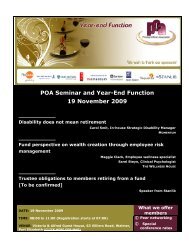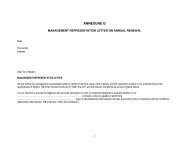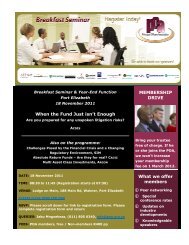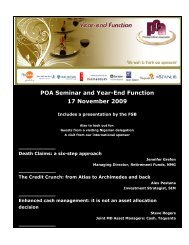Dr Jaco Maritz, Cadiz Securities
Dr Jaco Maritz, Cadiz Securities
Dr Jaco Maritz, Cadiz Securities
You also want an ePaper? Increase the reach of your titles
YUMPU automatically turns print PDFs into web optimized ePapers that Google loves.
<strong>Dr</strong> <strong>Jaco</strong> <strong>Maritz</strong>, <strong>Cadiz</strong> <strong>Securities</strong>
Transition Management – what is it?<br />
Common pitfalls<br />
How to keep it clean
Four questions:<br />
1. What is a transition?<br />
2. Do you need a transition manager?<br />
3. How do I select a transition manager?<br />
4. How do I know the job was done correctly?
Initial Portfolio<br />
Target Portfolio<br />
Sell<br />
Buy<br />
Common assets (“in<br />
kind”)
Specialised transition<br />
management is…<br />
<br />
<br />
<br />
<br />
the professional management of<br />
trading out of an initial portfolio<br />
and into new target portfolio<br />
by maximising in-kind transfer to<br />
save cost and trading impact<br />
while controlling for …<br />
– The specialised risks<br />
during the transition<br />
– the synchronising of the<br />
trades,<br />
– upfront and hidden costs<br />
Project management and risk management are key ingredients
Minimal loss of performance<br />
– Low cost<br />
– Always invested in the market<br />
– Track performance of the new portfolio<br />
Minimal break in the fund’s operations<br />
No break in fund’s financial records<br />
No assets lost in the process<br />
No chaos and no stress!<br />
It does not happened by itself!
Pre-transition Transition Trading Post-transition<br />
Financial Risk<br />
Operational Risk<br />
Operational Risk<br />
Operational Risk
Pre-transition Transition Trading Post-transition<br />
<br />
<br />
<br />
<br />
<br />
<br />
Proposed change to<br />
investments<br />
Selection process<br />
<br />
<br />
<br />
<br />
Implementation of<br />
trading plan<br />
Risk Management<br />
Due diligence or Trade execution<br />
Request for<br />
Proposal<br />
Source liquidity<br />
Quotation<br />
Service level agreement<br />
Pre-transition analysis<br />
Termination of mandates<br />
Appointment of<br />
custodian<br />
<br />
<br />
<br />
<br />
– Crossing<br />
Settlements<br />
Cash management<br />
Valuation<br />
Reporting<br />
<br />
<br />
<br />
<br />
Delivery of portfolios<br />
Post-transition report<br />
Financial reporting<br />
Closure of accounts
The global standard is a measure called implementation shortfall<br />
It is the difference between:<br />
Millions<br />
7,500<br />
7,400<br />
a notional portfolio transitioned instantaneously to the<br />
target portfolio with zero costs<br />
Portfolio value [R]<br />
7,300<br />
7,200<br />
7,100<br />
7,000<br />
Implementation shortfall<br />
…..and the transitioned portfolio with all costs included.<br />
6,900<br />
6,800<br />
Initial 19-Mar 20-Mar 23-Mar 24-Mar 25-Mar 26-Mar 27-Mar<br />
Actual Portfolio<br />
Paper Portfolio
Clients tend to focus on commissions...<br />
often to their own detriment!<br />
11%<br />
10%<br />
53%<br />
10%<br />
16% Commissions<br />
Estimated market<br />
impact<br />
Bid-offer spreads<br />
Missed trades<br />
Opportunity costs
( )<br />
2<br />
2 2<br />
2<br />
Tracking<br />
= β − β ) σ + σ<br />
error to target<br />
This is quadratic<br />
-The larger the beta differential is allowed to drift<br />
-The further your fund is up the steep section of the<br />
parabola!<br />
(<br />
source target target residual to target<br />
1.1<br />
8%<br />
1.0<br />
0.9<br />
Managing this beta<br />
differential is central!<br />
Can be exacerbated by the<br />
market moving during the<br />
transition<br />
7%<br />
6%<br />
5%<br />
Beta<br />
0.8<br />
0.7<br />
Translates into this large risk<br />
(tracking error)<br />
Target Beta = 0.793<br />
4%<br />
3%<br />
Tracking Error<br />
2%<br />
0.6<br />
1%<br />
0.5<br />
0%<br />
Initial<br />
19-Jan<br />
20-Jan<br />
21-Jan<br />
24-Jan<br />
25-Jan<br />
26-Jan<br />
27-Jan<br />
28-Jan<br />
31-Jan<br />
Beta<br />
Tracking Error
10.0<br />
9.0<br />
Tracking Error Variance<br />
8.0<br />
7.0<br />
6.0<br />
5.0<br />
4.0<br />
3.0<br />
Initial Risk<br />
One needs to target getting<br />
off the steep section of the<br />
parabola asap!<br />
Massive<br />
risk<br />
reduction<br />
2.0<br />
1.0<br />
0.0<br />
Now, if the market moves, the<br />
potential shortfall is small<br />
0.0 0.2 0.4 0.6 0.8 1.0 1.2 1.4 1.6 1.8 2.0<br />
Target Beta
What protection do you have?<br />
– Regulator does not police transition managers per se<br />
– Varying business models / service models
Does your transition manager have a well<br />
considered financial risk management strategy?<br />
Is the trading plan optimised to reduce risk?<br />
Do they have quantitative specialists that look at<br />
the financial risks?<br />
Does your transition manager manage the<br />
financial risk in real-time? - systems?
Project plan/time line<br />
Quantitative analysis of initial and target<br />
portfolios<br />
Analysis of trade lists – liquidity, risks, trading<br />
plan<br />
Cost estimate<br />
Estimate of implementation shortfall (range)
Comparison against pre-transition report<br />
Was the plan executed as stated?<br />
Cost/fee disclosure<br />
– Comparison against estimate<br />
Risk management – was it effective<br />
Implementation shortfall attribution<br />
– VWAP is inappropriate
Where does the transition management business<br />
fit within their organisation?<br />
– Bank<br />
– Brokerage<br />
– Asset consultant<br />
– Asset manager<br />
What is their business model?<br />
– Trading outsourced?

















